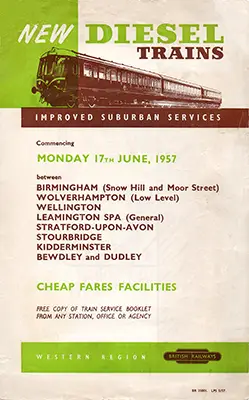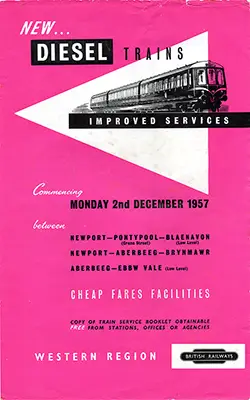DMU Operations: Western Region
The new DMUs delivered to the Western Region were all 64ft vehicles and predominately three-car sets. There were no low-density vehicles, the main type was high-density (suburban), the others were Inter-City, Cross-Country and parcel units. Although no Region had DMUs of all the same coupling code, the Western Region came the closest with just 18 vehicles delivered (of the Swindon 79xxx Inter-City type) that were not Blue Square.
The Region also had the highest number of distinct types (seven), only the Swindon 79xxx series, Class 120s and Class 128s were to be found new on other regions making the Class 116/117/118/119/121/122/123s distincly Western Region in the early years.
It received the second highest amount of new sets (309) formed from 861 vehicles:
| Type | Formations | Sets | Vehicles |
|---|---|---|---|
| Swindon 79xxx | 3-car | 6 | 18 |
| Class 116 | 3-car | 108 | 320 |
| Class 117 | 3-car | 42 | 123 |
| Class 118 | 3-car | 15 | 45 |
| Class 119 | 3-car | 28 | 81 |
| Class 120 | 3-car | 58 | 173 |
| Class 121 | 1/2-car | 16 | 26 |
| Class 122 | 1/2-car | 20 | 29 |
| Class 123 | 4-car | 10 | 40 |
| Class 128 | 1-car | 6 | 6 |
| Totals: | 309 | 861 |
Not included in the figures are the Diesel Pullman units or the AC Cars railbuses which the Region also had.
What became the Class 117s and Class 118s were originally scheduled to be built at Derby Works and would likely have just been more Class 116s — evolving into a 4-character headcode on the cab roof dome in the same way as the Class 108s did. However when the Class 127s were given the go ahead it was felt that only Derby could built them in the time period available. This was because new drawings would have to be produced for the underframe equipment layout — Derby would be able to start building the vehicles without the drawings being initially available whereas a contractor could not. And so the building work for the 168 Western Region vehicles (117 and 118s) was given to contractors as drawings were already available for them, allowing Derby to built the LMR Class 127s.
Before First Generation DMUs
Pre-Nationalisation several railways dabled with diesel railcars but it was the Great Western Railway that had the most success with what we now know as simply "GWR Railcars". These 38 vehicles were built between 1934 and 1941 and most lasted into the British Railways era becoming Western Region vehicles, many only being withdrawn when the First Generation DMUs (in particular the "bubble cars") were introduced to take their place. Much was learnt from these vehicles that was carried forward — AEC engines with Wilson epicyclic gearboxes (although Derby stubbornly tried its own thing first with Leyland engines and torque convertors), the bodywork on the GWR vehicles were contructed by builders that would build modernisation era types (Swindon Works, Park Royal and Gloucester RC&W).
One of the first routes the vehicles operated was between Birmingham Snow Hill and Cardiff General, the UK's first long distance diesel express service. When First Generation DMUs were introduced on the Western Region this was again a route covered on the inaugural day.
First Generation DMUs Delivered

The first passenger duties for the First Generation DMUs on the Western Region were on the first day of the Summer 1957 timetable on Monday 17 June when they were introduced to local and Inter-City services to South Wales from Birmingham Snow Hill.
Six three-car Swindon 79xxx sets were allocated to the Birmingham - Cardiff - Swansea services which they operated until replaced by Swindon Cross-Country sets just one year later. The Inter-City sets would then also work local services in the Birmingham area until moving to Scotland to join their counterparts in 1959.

The local services radiating from Birmingham Snow Hill were worked by Derby suburban triple sets (later known as Class 116s), for which the first 29 sets of the first batch were allocated to Tyseley (many remaining there until withdrawal). However only about half the intended sets had been delivered by that date so steam remained on some services (on which they had difficulties keeping time because of running around and water stops), causing the public to be sceptical.

The remaining 13 sets of the first batch of Class 116s were delivered to Cardiff (beginning August 1957). This allowed the first South Wales First Generation DMU services to be introduced on the 2nd December 1957 comprising the majority of services to/from the Eastern & Western Valleys between Newport and Blaenavon, and Newport, Brynmawr and Ebbw Vale (Low Level).
They were then introduced to the Cardiff Valley’s on Monday the 13th January 1958 working to places such as Barry, Treherbert, Aberdare, Merthyr and Llantwit Major.
Deliveries to Cardiff continued with the whole of batch two (53 sets), the last being delivered in July 1958. These were immediately followed by the thirteen sets of batch three which were delivered to Bristol Marsh Junction between July and November 1958.

Bristol phase one began on the 6th October 1958 involving some Bristol local services and the Chippenham - Calne branch. About half of the Bristol - Clifton Down - Avonmouth - Severn Beach - Pilning - Bristol, and Henbury line trips were now diesel worked.
Phase two began on Monday 17th November 1958 — all services on the Clifton Down line were now DMUs, main line workings included some Bristol to Westbury, Chippenham, and Weston-super-Mare returns.

Cardiff began to get deliveries of Swindon Cross-Country DMUs (later known as Class 120s) in November 1957, with 40 of the 49 sets from the first batch being delivered there by October 1958. They went into traffic on the 10th March 1958 replacing steam on some Cardiff-Bristol services and the Inter-City DMUs on one turn between South Wales and Birmingham. On the 21st April they started between Oxford and Birmingham, and they took over further services at the start of the summer timetable on the 9th June 1958.
The first of the "bubble cars" — the Gloucester Railway Carriage & Wagon version later known as Class 122s — began to be delivered in May 1958 to Reading, Tyseley and Southall (giving London its first First Generation DMUs). The latter two depots also received the accompanying trailer cars. The Birmingham sets entered traffic in May 1958 on the Leamington - Stratford, Birmingham - Dudley and Stourbridge Town - Stourbridge Junction services, while the London/Reading sets began working Ealing - Greenford branch on 25 August 1958, replacing the AEC/GWR railcars on the Slough to Windsor branch in September 1958. They also replaced these early railcars on the Twyford to Henley-on-Thames branch, and steam push-pull on the West Drayton to Staines branch on the 6th October 1958.
After these single cars GRC&W built Cross-Country sets (later known as a Class 119s) which were delivered between September 1958 and January 1960. Fifteen sets would be delivered new to Bristol (including the three two-cars), ten to Cardiff, and three to Tyseley. They were soon noted on workings from Bristol to Weymouth, Minehead and Portsmouth Harbour, from Cardiff to Pembroke Dock, and both Cardiff and Tyseley sets worked services between Birmingham and Cardiff and Swansea.
The London Operating District was determined to introduce DMUs with the winter timetable at the end of 1959 despite delays in the Pressed Steel suburban triples (later known as Class 117s) being delivered. They borrowed Class 116s and Class 120s from Tyseley and Cariff, Cardiff in turn borrowing Derby Lightweights from South Gosforth.
The 42 Pressed Steel units were delivered to Reading and Southall between November 1959 and October 1960 and took over duties from Paddington to destinations such as Banbury, Oxford, Reading and Slough. By mid-1961 there were also noted on Reading-Southampton services.
After the Class 117s Pressed Steel built their version of the "bubble car" (later known as Class 121s). They were delivered to Southall (9), Reading (4) and Bristol Marsh Junction (3) between September 1960 and February 1961, all 10 trailers went to Southall.
The last of the Region's new single car vehicles - the GRC&W parcel cars (later know as Class 128s) were delivered between January and April 1960, two to London and four to the Birmingham areas.
The 15 BRC&W suburban sets (later known as Class 118s) were delivered to Laira (13 sets, April to July 1960) for services in Devon and Cornwall, and West of Newton Abbott; and Bristol (2 sets in July 1960) for the Bristol - Taunton area.
The nine sets that comprised the third batch of the Swindon Cross-Country sets were delivered to Tyseley (the second batch had went to Scotland) between January and May 1961. They would work services such as Snow Hill to Oxford, and after about a year they all moved to Plymouth.
It was some time before the final new Western Region DMUs were delivered, ten four-car Inter-City sets (later known as Class 123s) to Cardiff between February and June 1963 and introduced on services between Swansea, Cardiff, Birmingham, Derby, Sheffield and Crewe.
By this time there had been many changes to the allocations and operations of the previous deliveries.
Services
Sample services:
Aberbeeg - Ebbw Vale
Barnstaple - Exeter
Barry Island - Merthyr
Birmingham - Bewdley & Stourport
Birmingham - Great Malvern
Birmingham - Hereford
Birmingham - Kidderminster
Birmingham - Leamington Spa
Birmingham - Stratford-upon-Avon
Birmingham - South Wales
Bristol - Severn Beach
Bristol - Weymouth
Cardiff - Chepstow
Cardiff - Weston-Super-Mare
Coryton - Cardiff Bute Road
Exmouth - Exeter
Henley - Twyford
Kemble - Cirencester/Tetbury
Lapworth - Wellington
Leamington Spa - Stratford-upon-Avon
Liskeard - Looe
Marlow - Maidenhead
Maiden Newton - Bridport
Merthyr - Cardiff
Newport - Blaenavon
Newport - Brynmawr
Paddington - Reading
Paddington - Oxford
Paignton - Exeter
Paignton - Kingswear
Par - Newquay
Plymouth - Gunnislake
Reading - Bedwyn
Reading - Gatwick Airport
Slough - Windsor
Stourbridge Jct - Town
Swansea - Carmarthen
Swansea - Shrewsbury
Taunton - Minehead
The Birmingham Pullman
The Bristol Pullman
The South Wales Pullman
Yatton - Clevedon
More lines will be added in the future!


